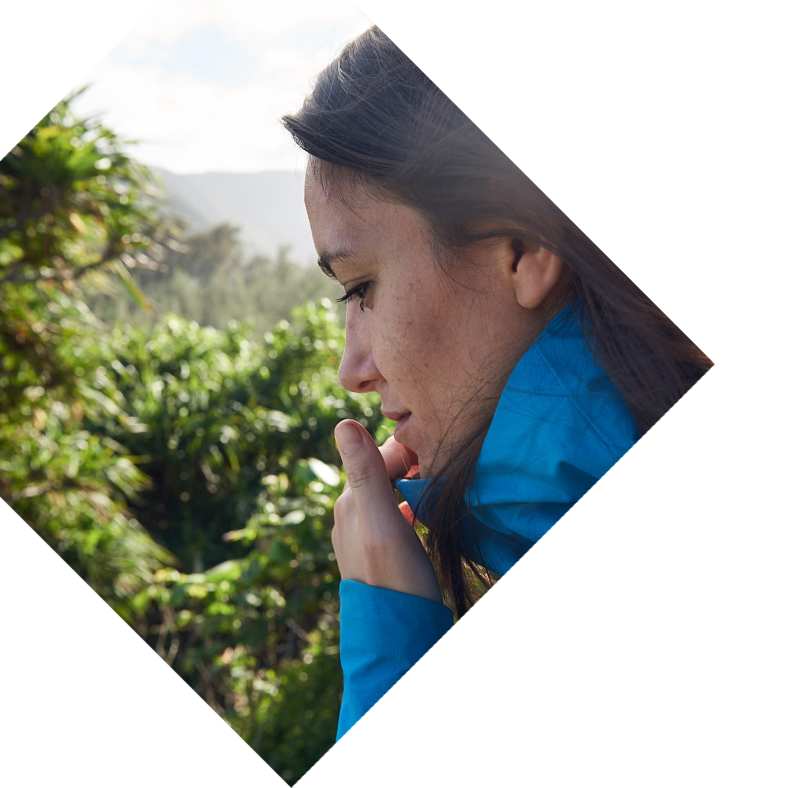We have a common dream: To explore Hawaii’s most stunning trails by tracing the four elements of ‘Earth’, ‘Water’, ‘Air’ and ‘Fire’. We, meaning photographer Manuel and design professional Nina, both from Munich, Germany. We’ve written about our adventures so that we can share them with the readers of the GORE-TEX blog. Before we set off on our trekking trip the crunch question was “What should we pack, and what should we leave at home?” Functionality, comfort and weight are key when it comes to long-distance hiking equipment. Seeing as you’re always wiser after the event, as soon as we got back from our trip we put together a list of our 11 packing tips. The climate in Hawaii is tropical. It experiences hot and humid weather with abundant rainfall, especially in winter, so that’s what you have to be prepared for. Temperatures only drop below zero at the top of the volcanoes on the Big Island. The maritime climate means that there’s also often a strong wind.
1. Backpack
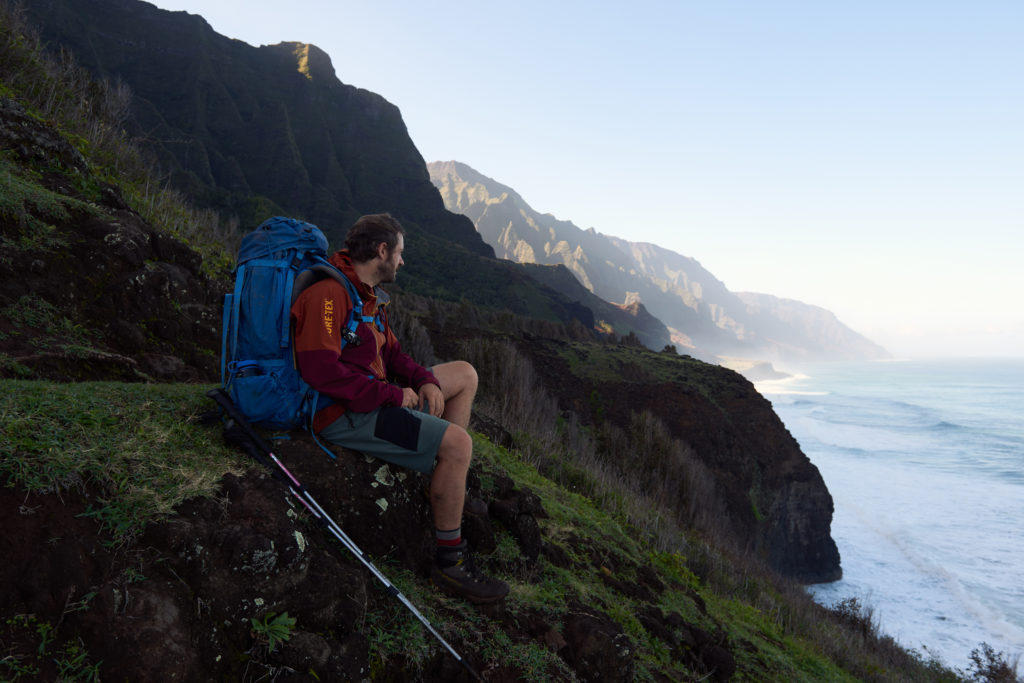 A backpack has to sit well on your back. Otherwise, a long-distance walk carrying a heavy backpack can end in agony. Get good advice when you’re choosing your backpack. Fill it and walk around the store with it on your back to test how it feels under weight. For our trip we had a 65 litre and a 75 litre backpack – space that we needed. We were carrying 12 kg and 17 kg, which was about as much as we could cope with. In the future, we would definitely try to carry less weight. Don’t forget how important a good rain cover is. Also, it’s a good idea to have a small day pack for shorter trips.
A backpack has to sit well on your back. Otherwise, a long-distance walk carrying a heavy backpack can end in agony. Get good advice when you’re choosing your backpack. Fill it and walk around the store with it on your back to test how it feels under weight. For our trip we had a 65 litre and a 75 litre backpack – space that we needed. We were carrying 12 kg and 17 kg, which was about as much as we could cope with. In the future, we would definitely try to carry less weight. Don’t forget how important a good rain cover is. Also, it’s a good idea to have a small day pack for shorter trips.
2. Tent
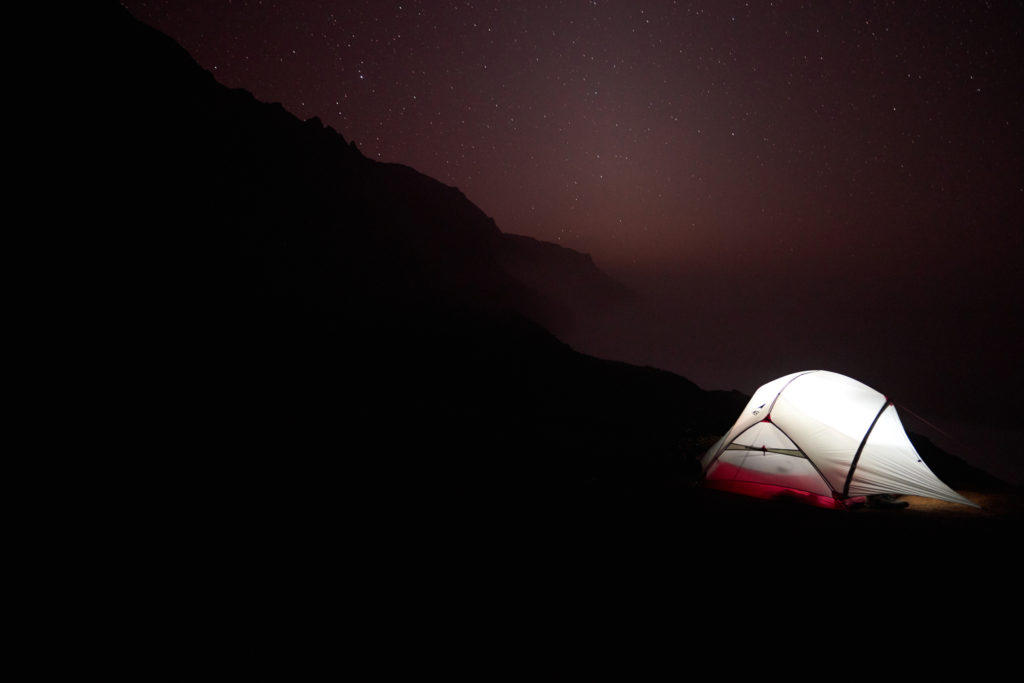 A good, high quality tent can help you save on weight. It should also be easy to set up. After a long day’s hike, you’re usually so tired that you go to bed almost as soon as you’ve finished your evening meal. Seeing as you’re only going to use it to sleep in, you can happily go for a smaller size. A hammock with a rainfly is a great alternative if you want to save on weight and are sure you can find enough trees.
A good, high quality tent can help you save on weight. It should also be easy to set up. After a long day’s hike, you’re usually so tired that you go to bed almost as soon as you’ve finished your evening meal. Seeing as you’re only going to use it to sleep in, you can happily go for a smaller size. A hammock with a rainfly is a great alternative if you want to save on weight and are sure you can find enough trees.
3. Sleeping mat and sleeping bag
Down-filled sleeping bags are more expensive but lighter than synthetic bags. Although, if down gets wet, it will take longer to dry. Everyone has individual preferences when it comes to sleeping mats. We decided to pack larger mats that were inflatable and insulated. After all, we were going to be on the go for almost three weeks and wanted to be able to sleep in comfort. For the extra comfort, we were prepared to carry that bit more weight. A more simple mat would also have done the job and would have been much lighter.
4. Clothing
Pack clothing that is breathable, waterproof and windproof. Not every garment has to be able to do everything, but a good rain jacket that is robust enough to cope with the strain of carrying a heavy backpack is essential. Breathable clothing will give you a much more comfortable and pleasant wearing experience, especially as you’re bound to work up a sweat from the constant exertion of lugging a full backpack. Windproof clothing will protect you against wind-chills and draughts, which is especially important after periods of intense physical activity. Our clothing was also at the more lightweight end of the spectrum and dried quickly. We packed a fleece top, a long sleeved jacket and a quilted jacket, any or all of which could be worn under our rain jackets to provide optimum protection against the cold. We also packed hats to keep our heads warm. If it’s cold and you’re not wearing a hat you very quickly start to feel chilled and uncomfortable. With our GORE-TEX products we were well equipped for the tour and really appreciated the benefits of waterproof, windproof and breathable clothing.
5. Footwear
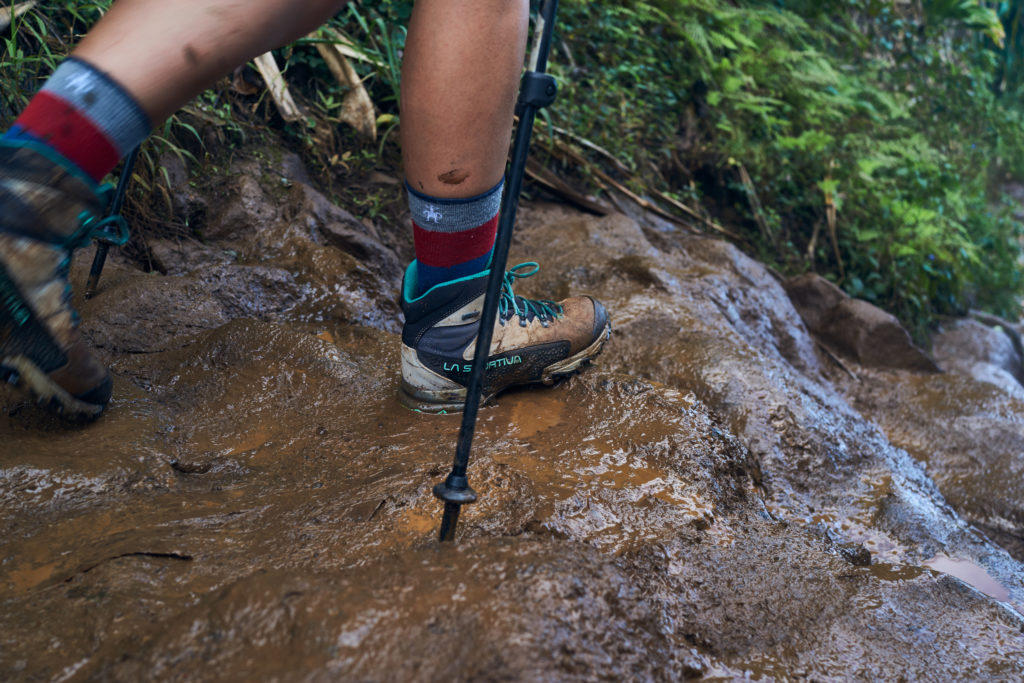 Hiking boots with outsoles that ’bit’ into the terrain proved to be hugely valuable on our long hikes, minimizing the likelihood of us slipping, stumbling or twisting our ankles. On the shorter trips where the ground underfoot was smoother, our lightweight trail running shoes offered a good alternative. The GORE-TEX SURROUND® product technology in both our hiking boots and our running shoes ensured that our feet stayed dry in mud and water and prevented sweat from building up. We didn’t get one single blister throughout the entire trip. High quality trekking socks are also essential. Ones made of Merino wool are especially great.
Hiking boots with outsoles that ’bit’ into the terrain proved to be hugely valuable on our long hikes, minimizing the likelihood of us slipping, stumbling or twisting our ankles. On the shorter trips where the ground underfoot was smoother, our lightweight trail running shoes offered a good alternative. The GORE-TEX SURROUND® product technology in both our hiking boots and our running shoes ensured that our feet stayed dry in mud and water and prevented sweat from building up. We didn’t get one single blister throughout the entire trip. High quality trekking socks are also essential. Ones made of Merino wool are especially great.
6. Poles
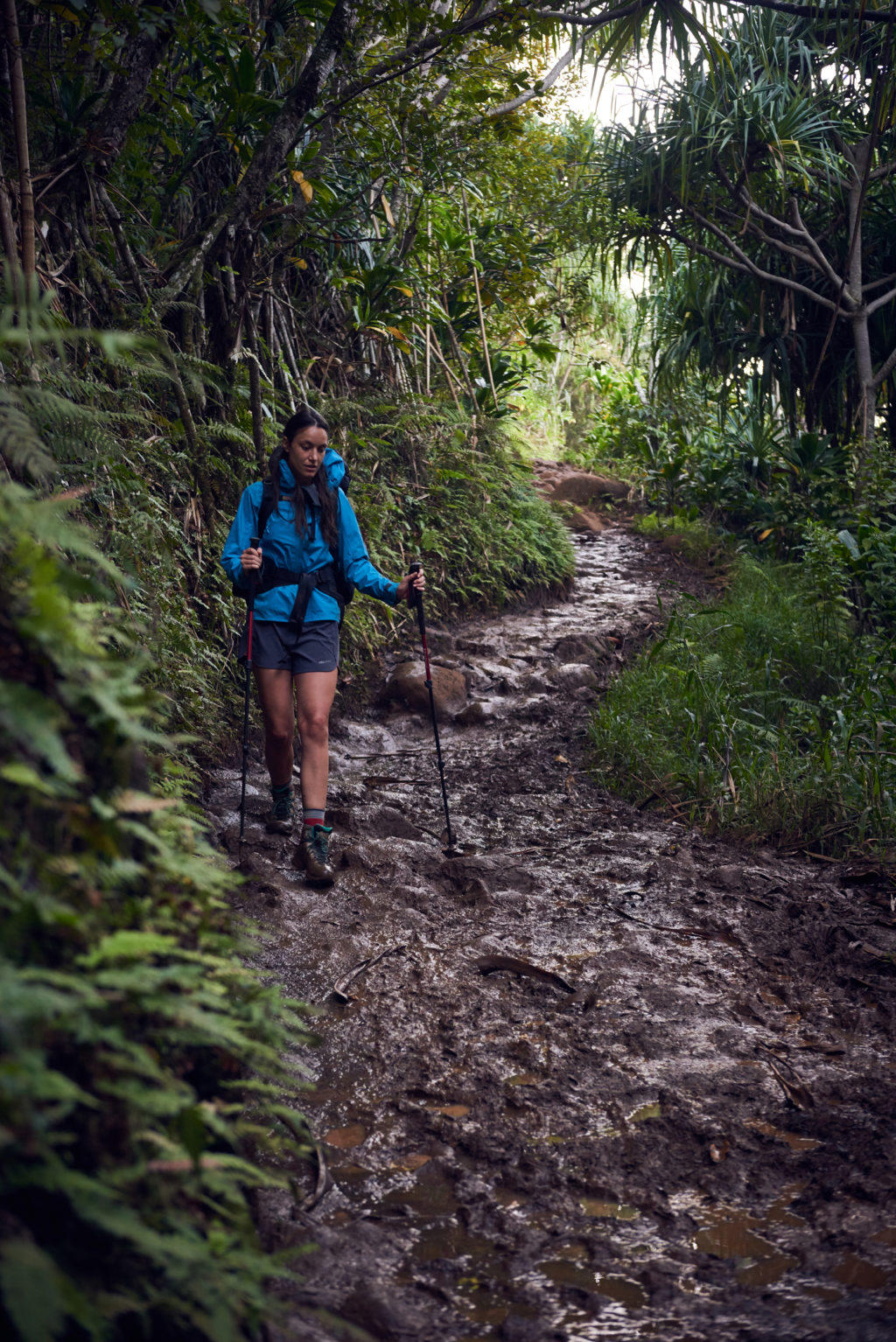 When you’re walking long distances with a heavy backpack, lightweight poles are crucial. They give you support and stability in rough terrain and help you keep a firm footing when you’re crossing rivers. They also relieve the strain on your joints. And, as they’re collapsible, they’ll fit in any backpack.
When you’re walking long distances with a heavy backpack, lightweight poles are crucial. They give you support and stability in rough terrain and help you keep a firm footing when you’re crossing rivers. They also relieve the strain on your joints. And, as they’re collapsible, they’ll fit in any backpack.
7. Cooking utensils
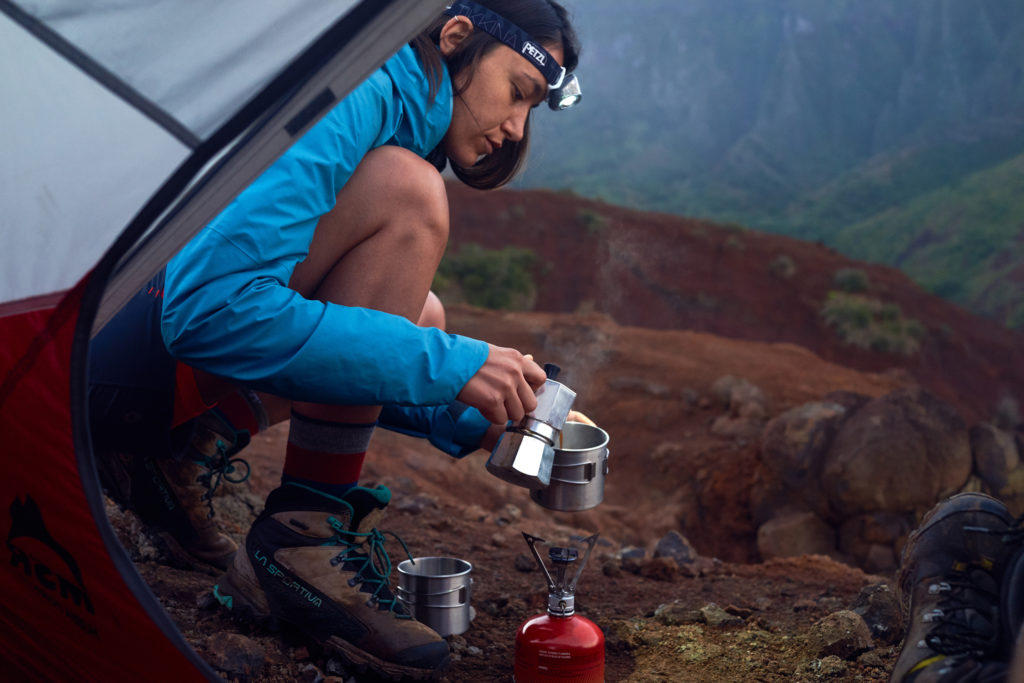 Cookers and cooking utensils should also be as light as possible. But, they do need to be sturdy and safe. For health reasons, make sure that any aluminium cookware has a good coating. Remember, you can’t take gas canisters on the plane and will have to buy them when you get to your destination. It’ll save time and your nerves if you check where you’ll be able to buy the right canister for your gas cooker before you set off.
Cookers and cooking utensils should also be as light as possible. But, they do need to be sturdy and safe. For health reasons, make sure that any aluminium cookware has a good coating. Remember, you can’t take gas canisters on the plane and will have to buy them when you get to your destination. It’ll save time and your nerves if you check where you’ll be able to buy the right canister for your gas cooker before you set off.
8. Lamps
The importance of a good head lamp is often underestimated – especially among first-time hikers. A head lamp that is a reliable source of light and has a powerful beam is a vital piece of kit in the dark – whether you’re cooking, pitching your tent, setting off before daybreak or returning after dark. Don’t forget to take extra batteries with you!
9. Water filter
There’s no way you can carry all the water you’ll need on a long trip. So you’re going to have to boil or filter it. Boiling water will make it safe to drink, but is time consuming. The alternative is to filter your water. Retailers offer various systems. Since you can’t do without drinking water and both filters and cookers can get damaged, you should also take along tablets that will convert water into safe drinking water.
10. Multi-tool
A multi-tool with a knife, saw, bottle opener, scissors and other practical tools is a hugely valuable piece of any kit.
11. First aid kit
A first aid kit complete with assorted bandages, medical tapes, plus a range of medication and remedies is crucial. Don’t forget to check the expiration dates of any medication or remedies you’ve had for some time.

